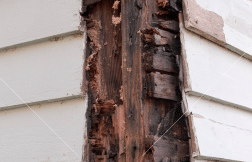SERVICES
Wood Destroying Pests and Organisms
Drywood Termites are so named because colonies live entirely in dry, sound wood. Unlike Subterranean termites, they require no connection with the soil and no above ground moisture source. All the moisture they need is obtained from the wood they consumed, or produce through their metabolism.
Attics and other relatively inaccessible locations in the upper parts of structures are common areas of drywood termite infestation. These termites also carry out their work completely inside the wood, often the only evidence of their presence is a few small holes through which they push frass (fecal material and undecomposed wood formed into tiny, football-shaped pellets) out of the galleries.

Subterranean Termites build their nests in the soil, and normally require continuous contact with soil to derive moisture for survival. Occasionally, they build their nests in above ground parts of a structure without maintaining soil contact, but there must be a continuous supply of water, such a leaky pipe, for this to occur. When wood is in contact with soil, termites can burrow from the soil directly into the wood. Foundation cracks, voids, hollow cement blocks and unbonded stucco may also provide hidden access to the structure for subterranean termites. If a barrier such as a concrete foundation exists between soil and wood, subterranean termites build earthen tubes over the barrier to bridge it. Once in contact with wood, the termites start boring and feeding inside in.
Signs of Infestation
 Mud Tubes. Earthen shelter (mud) tubes extending from the ground to the wood are common signs of infestation.
Mud Tubes. Earthen shelter (mud) tubes extending from the ground to the wood are common signs of infestation.
 Damaged Wood. Wood that is seriously damaged by subterranean termites breaks apart easily.
Damaged Wood. Wood that is seriously damaged by subterranean termites breaks apart easily.
 Swarmers. The presence of winged termites emerging indoors or from the building exterior is often the first sign of infestation noticed by homeowners.
Swarmers. The presence of winged termites emerging indoors or from the building exterior is often the first sign of infestation noticed by homeowners.
here are a number of different types of fungi which inhabit wood in structures, but decay fungi are the only ones which cause significant structural damage.
Wood allowed to remain damp will eventually decay no matter where it is in the structure unless it is naturally decay-resistant heartwood or has been pressure-treated with a preservative. That is why leaks or other sources of moisture contacting wood in the structure should be repaired immediately.
Soil contact is the most severe exposure condition for wood in structures: soil is not only a relatively continuous water source, but is also an effective source of fungal inoculum for infection of the wood, since decay fungi exist almost everywhere in it.

The only beetles usually requiring application of control measures in structure are the powderpost beetles.
- Lyctids
- Anobiid
- Bostrichid
The powderpost beetles mine the interior of wooden members and reduce them to talcum-powder-fine dust or tiny pellets which often drop out of adult emergence holes. They require immediate treatment because they can reinfest dry wood.





